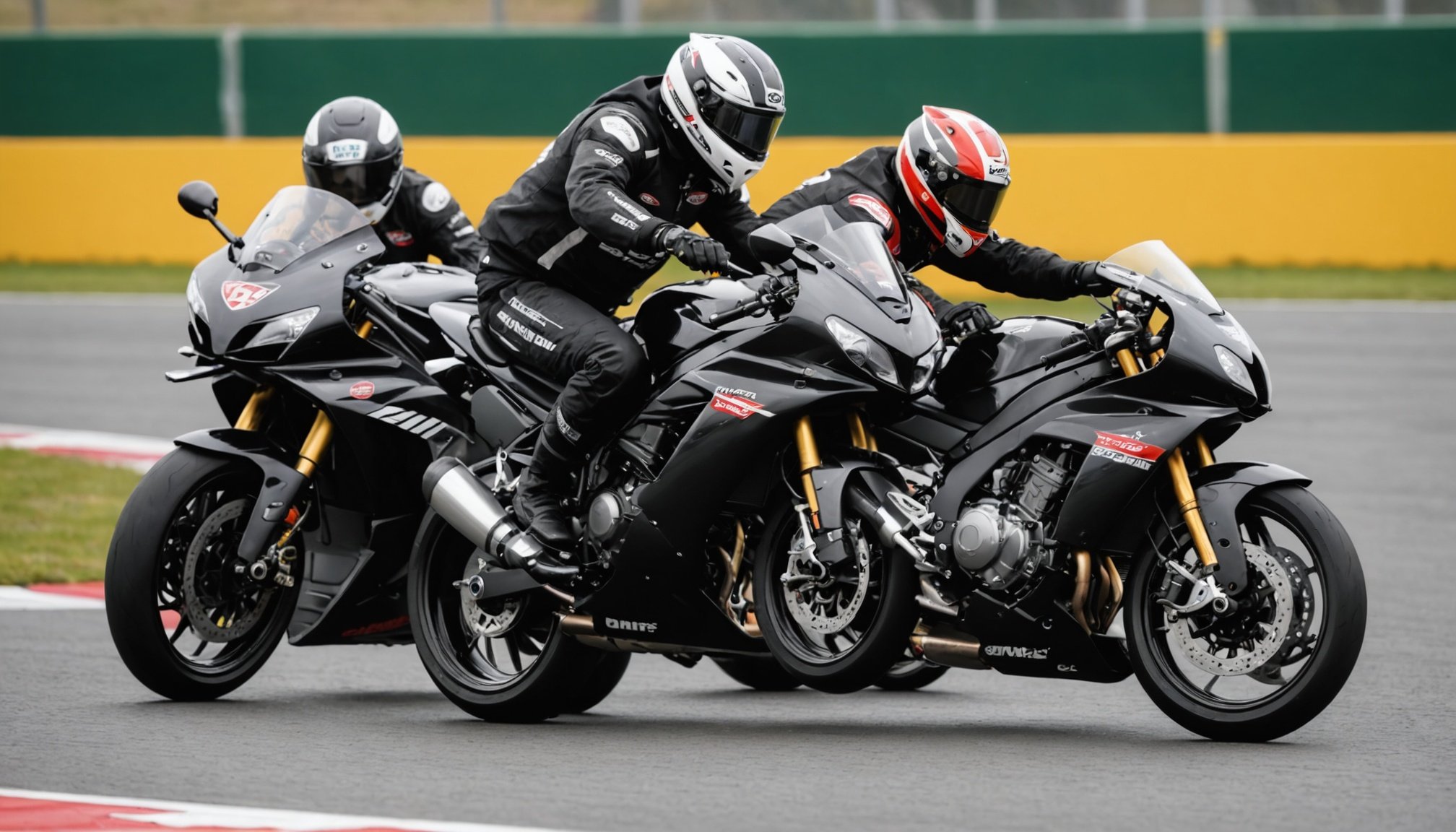Understanding Carburetor Synchronization
Carburetor synchronization is crucial for optimizing engine performance, especially in sport bikes. It ensures that all carburetors work in harmony, distributing fuel-air mixture uniformly across cylinders, crucial for maximum efficiency and power output during a track day. Achieving balance among carburetors affects throttle response and engine smoothness, ultimately enhancing a sport bike’s track performance.
On a track day, synchronized carburetors mean consistent power delivery and improved handling, directly impacting lap times. Without synchronization, the engine may run unevenly, leading to hesitations or power lags, which can be detrimental to performance-focused riders. Proper synchronization allows riders to fully utilise their bike’s capabilities, ensuring optimal performance and secure handling.
Have you seen this : Ultimate Ear Protection for UK Motorcyclists: Protect Your Hearing While Riding!
Carburetors function as the bike’s lungs, mixing air with fuel to power the engine. Each cylinder has its own carburetor, so they must be meticulously balanced. The synchronization process adjusts each carburetor so that they all work together seamlessly. Sport bikes, designed for high performance, require precise carburetor synchronization to ensure peak performance. This process fine-tunes the engine’s responsiveness and can directly influence the bike’s efficiency and power during intense riding situations. On a track day, every advantage counts, making carburetor synchronization an essential aspect of sport bike maintenance.
Essential Tools for Carburetor Synchronization
When embarking on a journey to optimize your sport bike’s performance, having the right synchronization tools is non-negotiable. A well-equipped toolkit ensures precision, making your bike truly track ready. Understanding what tools are necessary can significantly enhance your bike maintenance routine, setting a foundation for success.
Also read : Ultimate Guide to Enhance Your UK Sport Bike’s Visibility with the Best Aftermarket Mirrors
Necessary Tools Overview
To effectively synchronize carburetors, certain gadgets are indispensable. The primary tool is the vacuum gauge set or synchronometer, which measures the pressure in each carburetor, allowing you to balance them accurately. A small screwdriver is also essential for adjusting the synchronization screws, granting swift yet precise adjustments. Additionally, a carburetor synchronizer tool, such as a CarbTune Pro, is crucial for optimal readings.
Recommended Brands and Models
Selecting the right brand is crucial for accuracy and ease of use. Popular choices include Motion Pro and Morgan Carbtune. The Motion Pro Synchronization Tool is renowned for its durability and precision, while the Morgan Carbtune Pro offers ease of use and reliable measurements, making it a favourite among enthusiasts.
Preparing Your Workspace
A neat, organised workspace enhances the efficiency of the synchronization process. Ensure that the area is well-lit and equipped with a stable surface or bike stand for securing the bike. An organised space minimizes errors and allows for seamless tuning.
Step-by-Step Guide to Synchronizing Carburetors
Embarking on carburetor tuning begins with thorough preparation. Safely secure your sport bike to ensure stability during adjustments. This forms the backbone of the synchronization process and sets the stage for performance optimization.
Begin by warming the engine to its normal operating temperature, as the synchronization is most accurate when the engine mimics track-day conditions. After the engine is warmed up, attach your synchronization tools to monitor the vacuum balance of each carburetor.
The synchronization process typically involves adjusting idle screws until uniform vacuum readings are achieved across all carburetors. Start by tweaking the primary carburetor until it reaches its perfect idle vacuum. Gradually adjust the other carburetors to match, using the readings from your synchronometer or vacuum gauge set. Listening to the engine’s response and checking throttle responsiveness regularly is crucial.
During tuning, measure key parameters such as engine RPMs and throttle response. Look for smooth transitions in the throttle when accelerating or decelerating. Fine-tuning these aspects assuredly enhances performance optimization for track-ready conditions. After synchronizing, conduct a final check for any discrepancies.
Regular check-ups keep synchronization aligned with optimal engine performance, ensuring your sport bike roars with precision on every track day.
Troubleshooting Common Carburetor Issues
Experiencing issues with carburetor synchronization can be frustrating, especially when preparing for a track day. Recognising common problems is essential for optimal sport bike performance. Typical issues include uneven idling, poor throttle responsiveness, and unusual engine noises. Understanding these symptoms can help pinpoint the underlying causes of synchronization problems.
When diagnosing performance anomalies, start by checking for air leaks around the carburetor manifold. Ensure that the vacuum lines are intact and free from obstructions. Adjustments should be made cautiously to avoid exacerbating issues. Precision is key to resolving discrepancies in synchronization. Incorrect air-fuel mixtures can also cause problems; hence, balancing must be fine-tuned regularly.
If issues persist after basic checks, consider testing each carburetor separately. This helps identify which carburetor might be causing the imbalance. Maintain thorough records of adjustments to track changes and recognise patterns in performance issues. For effective performance fixes, consult a detailed troubleshooting manual or seek advice from experienced mechanics familiar with your bike model.
Efficiently addressing carburetor issues ensures your sport bike remains track-ready. Utilising the right techniques and expertise will improve its reliability and smoothness, enhancing both your riding experience and lap times. Regular maintenance and attention to detail are crucial to prevent future synchronization challenges.
Advanced Techniques for Enhanced Performance
Unlocking enhanced performance requires diving into advanced synchronization tips. For those seeking a competitive edge, fine-tuning adjustments are crucial. By meticulously adjusting the sync screws, precision can be achieved, ensuring that each cylinder operates in perfect harmony.
Fine-tuning Adjustments
Fine-tuning involves cautiously balancing each carburetor for optimal air and fuel delivery. Adjust the synchronization to maintain perfect vacuum levels, allowing your sport bike to unleash its full potential.
Integrating Air-Fuel Mixture Optimization
Optimal performance is linked to the perfect air-fuel mixture. Consider using high-performance jets and ensuring clean air filters. This ensures maximum efficiency and power output, crucial for a track day environment. Regularly check and adjust the mixture to match riding conditions, adapting your settings to maintain peak sport bike performance.
Regular Maintenance Routines
Establishing a consistent routine guarantees sustained performance. Schedule regular check-ups and clean the carburetors frequently to prevent blockages. Inspect synchronization tools for accuracy to ensure reliable readings. Regular maintenance helps recognise potential issues early, preventing them from escalating and ensuring your sport bike remains track-ready. Implementing these expert techniques positions your bike for superior track success.
Real-world Testimonials and Success Stories
Exploring real-world user experiences sheds light on how precise carburetor synchronization transforms sport bike performance. Riders often share that achieving perfect synchronization critically enhances their track day endeavors, delivering smoother power output and bolstering their confidence in each lap.
Case Study Analysis
In a detailed case study, a rider who previously struggled with uneven power delivery reported substantial performance improvements after accurate synchronization. The effort resulted in consistently better lap times and a noticeably smoother engine response, reflecting the profound impact of proper tuning. Such experiences underscore the importance of attention to detail in synchronization.
Community Feedback Highlights
The biking community frequently emphasizes the profound effects that fine-tuning synchronization has on performance improvement. For example, one enthusiast noted how meticulous adjustment of synchronization reduced fuel consumption, enhancing efficiency during prolonged track sessions. This is echoed across many forums and rider groups, showcasing the positive transformation riders see when synchronization is perfected.
Lessons Learned from the Track
From these shared experiences, it’s clear that paying meticulous attention to synchronization details leads to substantial track success. Key recommendations include regularly checking synchronization settings pre-track day and adjusting for temperature changes to maintain optimum performance. This continuous learning process from community insights contributes significantly to achieving superior sport bike performance.
UK-Specific Considerations for Track Days
Understanding UK regulations related to track days is crucial for optimising carburetor tuning and ensuring safe participation in sport bike events. UK-specific rules dictate safety requirements, bike specifications, and permissible noise levels, which directly impact how riders prepare their bikes. Ensuring compliance with these regulations not only assures participation but also enhances track experience without unwelcome penalties.
The UK’s often unpredictable weather presents challenges for track day preparation. In cooler or damp conditions, carburetor synchronization may need adjusting to account for denser air, affecting the air-fuel mixture. Riders are advised to regularly check and calibrate their carburetors, ensuring peak sport bike performance regardless of weather changes.
Regional tuning needs require acknowledging local climate deviations and the track’s elevation, influencing the bike’s carburetor settings. Riders should consider equipping their bike with tuning tools suitable for quickly adapting to these variable conditions, allowing for efficient performance adjustments on the day.
Familiarising oneself with the intricacies of regional regulations and tailoring one’s bike accordingly proves advantageous, promoting both safety and competitive edge. Complying with local guidelines ensures riders can focus wholly on their track performance, maximising their enjoyment and success.




